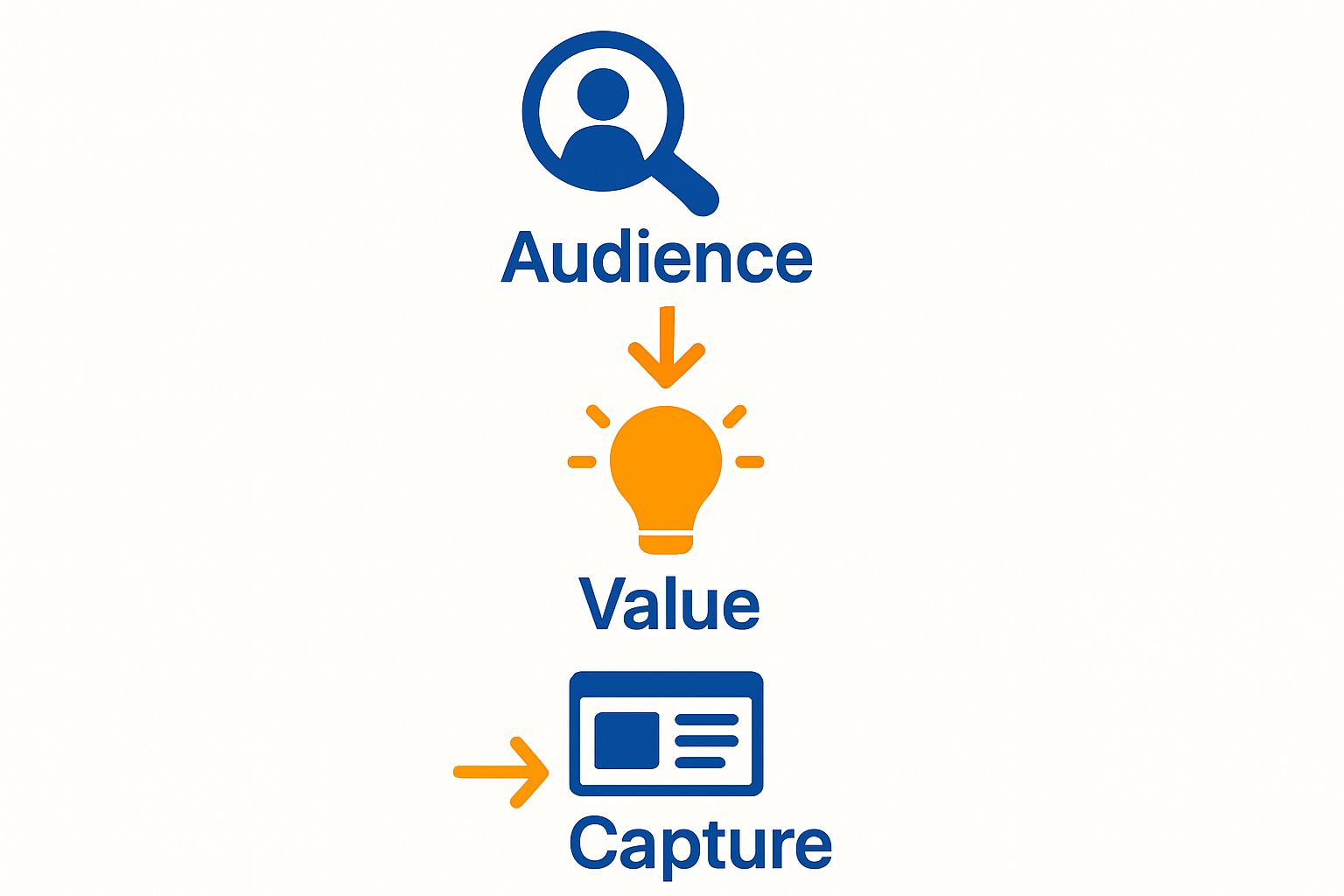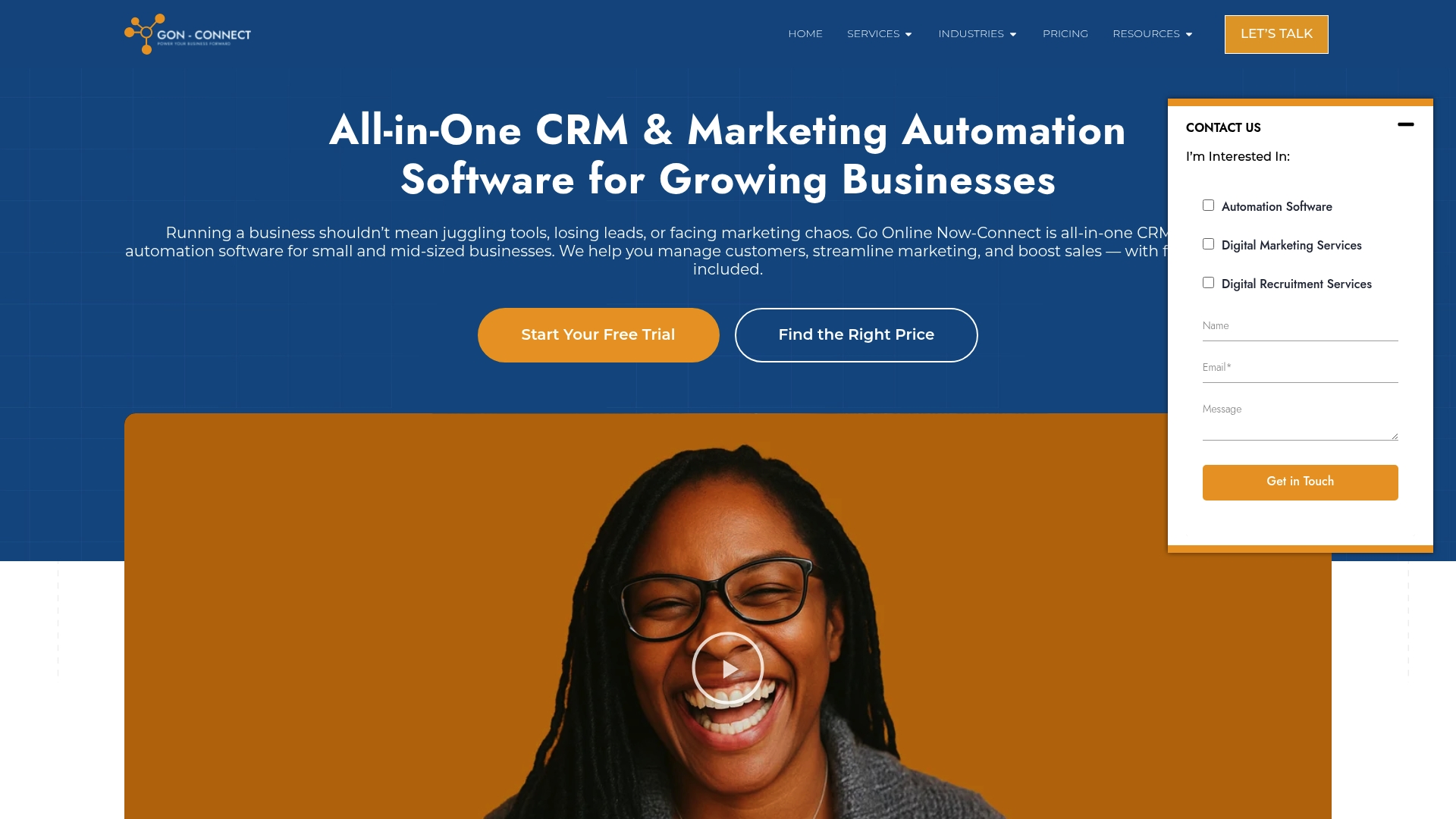Most companies think lead generation is all about chasing as many prospects as possible. But businesses that go beyond basic demographics and focus on psychological profiles and real customer journeys consistently see higher conversion rates and better quality leads. The real magic happens when you switch from spray-and-pray tactics to building a dynamic process grounded in deep understanding, clear goals, and smart data—radically changing how your pipeline fills up.
Stap 1: Definieer uw doelgroep en doelen
Successful lead generation begins with crystal clear understanding of who you want to attract and what specific outcomes you aim to achieve. This foundational step transforms random marketing efforts into a precision-targeted strategy that connects with the right prospects at the right moment.
Starting your lead generation process requires deep audience research and strategic goal setting. Begin by developing comprehensive audience personas that go beyond basic demographics. Explore psychological profiles, professional challenges, aspirational goals, and online behavior patterns that reveal your ideal customer’s motivations and decision-making triggers. This means diving into data sources like customer surveys, social media insights, website analytics, and direct market research.
learn more about strategic audience targeting by understanding not just who your customers are, but what drives their purchasing decisions. Mapping out detailed customer journeys helps you anticipate needs and design lead generation strategies that feel personally relevant.
Your goals must be specific, measurable, and aligned with broader business objectives. Instead of vague targets like “generate more leads,” articulate precise outcomes such as “acquire 50 qualified B2B technology consultancy leads within the next quarter” or “increase conversion rates by 25% through targeted email marketing campaigns.” Quantifiable goals provide clear benchmarks for measuring lead generation effectiveness.
Critical goal-setting elements include:
- Defining precise numerical targets
- Establishing realistic timeframes
- Identifying key performance indicators (KPIs)
- Creating mechanisms for tracking and reporting progress
Successful audience definition and goal setting requires continuous refinement. Regularly review your personas and objectives, adjusting strategies based on emerging market trends, technological shifts, and actual performance data. Treat your lead generation framework as a dynamic, evolving system that adapts to changing business landscapes.
Below is a summary table of the five main steps in the lead generation process, including key actions and desired outcomes for each.
| Stap | Belangrijkste acties | Desired Outcome |
|---|---|---|
| 1. Define Target Audience and Goals | Develop detailed personas, analyze data, set measurable goals | Clear understanding of ideal customer and quantifiable objectives |
| 2. Develop Value Propositions | Identify pain points, craft messaging, test resonance | Messaging that directly appeals to prospect needs |
| 3. Implement Multi-Channel Outreach | Blend digital and traditional channels, personalize content | Broad and effective engagement across platforms |
| 4. Optimize Landing Pages | Refine design, minimize form fields, add trust signals | Increased conversion of visitors to leads |
| 5. Analyze and Refine Tactics | Monitor KPIs, conduct reviews, test improvements | Continuous optimization of lead quality and conversion rates |

Verify your audience and goals are well-defined by asking: Can I describe my ideal customer in rich, specific detail? Do my goals connect directly to measurable business outcomes? If you can answer confidently, you have completed this critical first step in the lead generation process.
Step 2: Develop Compelling Value Propositions
After defining your target audience, the next critical step is crafting value propositions that genuinely resonate and spark immediate interest. A powerful value proposition transforms your marketing from generic messaging to a targeted communication that speaks directly to your prospect’s deepest needs and aspirations.
Developing a compelling value proposition requires understanding the precise pain points and desired outcomes of your target audience. This means going beyond surface-level benefits and diving into the emotional and practical challenges your potential customers face. Analyze your audience research from the previous step to identify specific problems your product or service solves uniquely.
explore strategic marketing approaches that help you articulate your value in language that feels personalized and urgent. According to CXL Institute, effective value propositions focus on tangible, measurable benefits rather than abstract claims.
Craft your value proposition by answering three fundamental questions: What makes your solution different? What specific problem do you solve? Why should a potential customer choose you over alternatives? Your messaging should create an immediate connection that makes prospects think, “This is exactly what I need.”
Consider structuring your value proposition with these critical components:
- A clear, concise headline that captures the core benefit
- A short paragraph explaining the unique solution
- Specific, quantifiable outcomes or results
- An emotional hook that connects with the audience’s deeper motivations
Test your value proposition by presenting it to a small group of potential customers. Look for immediate reactions of recognition and interest. If their response is confusion or indifference, refine your messaging. The goal is creating a statement so relevant that prospects feel it was written specifically for them.
Remember that value propositions are not static. As market conditions change and customer needs evolve, your messaging must adapt. Regularly review and update your value propositions to ensure they remain sharp, relevant, and compelling. A great value proposition is a living document that grows with your understanding of your customers.
Step 3: Implement Multi-Channel Outreach Strategies
Successful lead generation demands a sophisticated approach that reaches potential customers through multiple interconnected channels. Multi-channel outreach allows you to create a comprehensive engagement strategy that meets prospects where they naturally spend their time and attention.
Developing an integrated outreach strategy requires understanding the unique strengths of each communication channel. Your approach should blend digital and traditional methods, creating a seamless experience that nurtures leads through their entire decision-making journey. This means synchronizing your messaging across email, social media, content marketing, paid advertising, and direct outreach to create a cohesive brand narrative.
explore advanced digital marketing techniques that can amplify your multi-channel approach. Start by mapping out your customer’s typical interaction points, considering how different channels complement each other. For instance, a prospect might first encounter your brand through a social media advertisement, then receive a targeted email, and finally engage through personalized content.
Email marketing remains a powerful foundation for lead generation. Develop segmented email campaigns that deliver highly personalized content based on the specific interests and behaviors of different audience segments. Combine automated email sequences with thoughtful, manually crafted follow-up communications that feel genuine and responsive.
Key multi-channel strategy components include:
- Consistent messaging across all platforms
- Targeted content for each channel
- Integrated tracking and analytics
- Gepersonaliseerde communicatiebenaderingen
- Seamless user experience transitions
Social media platforms offer unique opportunities for engagement. Create platform-specific content that resonates with the audience’s expectations and behaviors. LinkedIn might require more professional, detailed content, while Instagram demands visually compelling storytelling. The goal is to make each interaction feel intentional and valuable.
Verify your multi-channel strategy’s effectiveness by monitoring key performance indicators across different platforms. Look for consistent engagement, increasing conversion rates, and a growing pipeline of qualified leads. A successful multi-channel approach should feel like a natural conversation that guides prospects toward your solution, rather than a disjointed series of marketing attempts.
Step 4: Optimize Landing Pages for Lead Capture
Landing pages serve as the critical conversion point in your lead generation strategy, transforming interested prospects into potential customers. These focused web pages must be meticulously designed to capture visitor attention and motivate immediate action.
Effective landing pages require surgical precision in design, messaging, and user experience. Your page should eliminate all distractions and create a clear, compelling pathway for visitors to provide their contact information. This means crafting a narrative that speaks directly to the specific pain points and desires you identified when developing your value proposition.
discover advanced conversion strategies that can transform your landing page performance. According to CXL Institute, minimizing form fields and creating a direct, benefits-focused headline can dramatically improve conversion rates.
Design your landing page with a laser focus on user psychology. The visual hierarchy should guide the visitor’s eye naturally toward the primary call to action. Use high-contrast colors, clear typography, and strategic white space to create an inviting, professional appearance. Your headline must communicate the core value proposition within seconds, answering the critical question: “What’s in it for me?”
Key landing page optimization principles include:
- Minimal, relevant form fields
- Clear and compelling value statement
- Mobile-responsive design
- Fast loading speed
- Trust signals like testimonials or certifications
Incorporate social proof elements that build immediate credibility. Customer testimonials, industry certifications, client logos, and quantifiable results can transform a generic landing page into a trust-building machine. Remember that prospects are looking for reassurance that your solution will solve their specific problem.
Use the checklist below to verify that critical landing page elements for lead capture optimization are in place before launching your campaign.
| Landing Page Element | Doel | Complete? |
|---|---|---|
| Minimal, relevant form fields | Reduces friction and increases conversions | [ ] |
| Clear and compelling value statement | Communicates main benefit instantly | [ ] |
| Mobile-responsive design | Ensures usability on all devices | [ ] |
| Fast loading speed | Prevents visitor drop-off | [ ] |
| Trust signals (testimonials, certifications) | Builds credibility and reduces hesitation | [ ] |
| Strong call to action | Directs visitor toward next step | [ ] |
Verify your landing page’s effectiveness by monitoring key metrics like conversion rate, bounce rate, and time on page. A high-performing landing page should consistently convert at least 2-5% of visitors, with top performers reaching even higher conversion rates. Continuous testing and incremental improvements will help you refine your approach and maximize lead capture potential.

Step 5: Analyze and Refine Your Lead Generation Tactics
Lead generation is an evolving process that demands continuous measurement, analysis, and strategic refinement. Without systematic evaluation, even the most sophisticated marketing strategies can become ineffective over time. The final step in your lead generation process focuses on transforming raw data into actionable insights that drive consistent improvement.
Implementing a robust analytics framework is crucial for understanding the true performance of your lead generation efforts. This means going beyond surface-level metrics and diving deep into the nuanced indicators that reveal genuine marketing effectiveness. Track not just the quantity of leads, but the quality, conversion rates, and long-term customer value.
explore comprehensive lead generation strategies that emphasize data-driven decision making. Utilize advanced analytics tools that provide granular insights into every stage of your lead generation funnel. These platforms should help you understand which channels, messaging, and tactics are generating the most qualified leads.
Develop a systematic approach to data analysis that breaks down your lead generation performance into measurable components. Examine metrics like cost per lead, conversion rates across different channels, engagement levels, and the actual revenue generated from your lead generation efforts. Look for patterns that indicate which strategies are delivering the most significant returns and which need immediate recalibration.
Key performance analysis strategies include:
- Conducting monthly comprehensive performance reviews
- Comparing performance across different marketing channels
- Identifying high-performing customer segments
- Tracking lead quality and conversion progression
- Calculating precise return on investment metrics
Continuous improvement requires a willingness to experiment and pivot. Set up A/B testing protocols that allow you to systematically test different approaches in your lead generation strategy. This might involve experimenting with different landing page designs, email subject lines, advertisement copy, or targeting parameters. Small, incremental improvements can compound into substantial performance gains over time.
Verify the success of your analysis and refinement process by establishing clear benchmarks. A well-optimized lead generation system should show consistent improvement in key metrics such as lead quality, conversion rates, and customer acquisition cost. Remember that the most successful businesses view lead generation as an ongoing journey of learning and adaptation.
Transform Your 2025 Lead Generation With a Smarter, Simpler Platform
If you are ready to define real goals, develop compelling value propositions, and establish a multi-channel lead generation process as outlined in this guide, but feel overwhelmed by scattered tools and manual processes, you are not alone. Many business owners stall at turning deep audience insights and strong strategies into real results. If you are struggling to connect channels, track leads, or automate your marketing, there is a proven solution designed just for you. Curious about how streamlined marketing automation tools can multiply your results?

Experience the future of digital growth with Ga nu online - Maak verbinding. You get every essential feature—email automations, unified CRM, done-for-you setup, and hands-on support—in one easy platform. Stop missing out on qualified leads or wasting hours with over-complicated systems. Take the next step and visit our Digitale marketingoplossingen or start building your lead generation engine directly with Go Online Now-Connect. Get started today to secure your 2025 success before competitors catch up.
Veelgestelde vragen
How do I define my target audience for lead generation in 2025?
To define your target audience, develop comprehensive audience personas that include their psychological profiles, challenges, and online behavior patterns. Start by conducting customer surveys and analyzing social media insights to gather deep insights about your ideal customers.
What are effective strategies for crafting value propositions for lead generation?
Effective strategies for crafting value propositions include identifying your target audience’s specific pain points and how your solution addresses them. Create a clear headline and outline measurable outcomes to ensure your value proposition resonates personally and highlights your unique offerings.
How can I implement multi-channel outreach strategies for better lead generation?
To implement multi-channel outreach strategies, synchronize your messaging across various platforms such as email, social media, and content marketing. Create targeted content for each channel to meet your audience where they are, ensuring a seamless and engaging customer journey.
What should I focus on when optimizing landing pages for lead capture?
When optimizing landing pages, focus on clear messaging, minimal form fields, and trust signals like testimonials. Ensure your page has a mobile-responsive design and a strong call to action that compels visitors to provide their contact information immediately.
How do I analyze and refine my lead generation tactics effectively?
To analyze and refine your lead generation tactics, implement a robust analytics framework to track key performance metrics such as conversion rates and cost per lead. Conduct monthly performance reviews to identify high-performing strategies, enabling you to make data-driven adjustments that improve results over time.
How can I set measurable goals for lead generation success in 2025?
To set measurable goals for lead generation, define clear numerical targets, establish realistic timeframes, and identify key performance indicators (KPIs). For example, aim to acquire a specific number of qualified leads within a set period, which will help you monitor progress and adjust tactics as needed.
Aanbevolen
- 7 Essential Lead Generation Tips for Small Businesses – Go Online Now
- Effective Lead Generation Campaign Guide for Businesses – Go Online Now
- Effective Lead Generation Workflow Tutorial for Businesses – Go Online Now
- How to Create Sales Funnels That Convert Customers – Go Online Now
- Optimalisatie van landingspagina's: bewezen strategieën voor 2025

